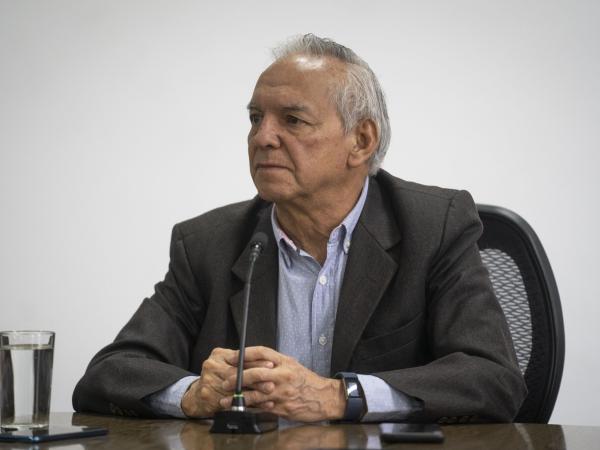Finally, after the repeated insistence of the Ministry of Finance and the controversy over the warnings made by President Gustavo Petro that did not go down well in several sectors, the joint third commissions of the Senate and Chamber began this Tuesday – May 28 – the discussions of the bill that seeks to raise the country’s debt ceiling by US$17 billion.
In a processing session, prior to the vote on this project in the first debate, the Ministry of Finance announced the details of how these resources are planned to be used, making it clear that in 2028 it would be necessary to expand again the debt quota, taking into account the commitments acquired.
Ricardo Bonilla, Minhacienda.
BLOOMBERG
The Minister of Finance, Ricardo Bonilla, began by saying that this change is necessary, taking into account the country’s financial needs derived from the pandemic and other obligations and loans acquired in previous years to reactivate the economy that was affected by phenomena such as confinement. and deceleration.
Read here: Freezing spending, the possible way out of the fiscal gap in the National Government
“Colombia today has an approved debt quota for 2020 that It reached up to US$70,000 million. Due to the pandemic, the country received a substantial increase in the public debt index, with which we went from 48% of GDP to 61% of GDP. “That is a very strong increase, which means that the Government not only borrowed within what was foreseen in the quota, but also used, with emergency decrees, credit resources for US$12,000 million that are not within the quota.” , he indicated.

Ministry of Finance and Public Credit.
Photo: CEET – Néstor Gómez
During his presentation, Bonilla González referred to the credit that one has with the International Monetary Fund and recalled that it is money that is being paid, but that it does not free up cash space to be used for other requirements, a situation which, added to the commitments that are being fulfilled today, put the country in a challenging context.
Other news: These are the brands that would change owners with the potential sale of Nutresa
“With this credit we find that paying it does not make room for us in the debt quota. The quota is somewhat flexible, when one goes into debt the availability closes, when one pays the availability opens. We are paying from the bottom and there is no availability. So, the cash situation is leaving us complicated,” he highlighted.

Congress of the republic.
EL TIEMPO Archive
The head of this portfolio recalled that Colombia must pay US$5.5 billion in debt this year, US$8 billion in 2025 and US$7 billion in 2026; making it clear that these requirements exceed the current cash availability, which barely reaches US$2,000 million and justifies the need to expand the quota.
You may be interested in: EPS Sura settlement: what will happen to users and the prepaid medicine service
“What the last governments have been doing is starting to pay the commitments that led the debt to be above 60% of GDP. We managed to leave it at 53.8% of GDP in 2023 and this year we aspire to keep it around 57%, which means that we are paying debt and not acquiring debt,” he said in this regard.

Colombian pesos
iStock
Now, regarding how exactly the US$17,000 million that they are requesting as a quota application from Congress will be used, the Ministry of Finance explained that US$5,500 would be used in 2024, while in 2025 It would rise to US$8.8 billion and in 2026, ending in August, the projection points to US$4.038 million.
You may be interested in: Income tax return: online applications that will help you with the process
“We are asking Congress to open up the debts of the debt quota, there are US$12,000 million that must be incorporated because they are not in the quota, plus what the debt that is committed leaves in terms of interest or debt service. So, it is expected that between now and 2026 we will have to pay close to $US10,000 million in interest,” said this official.

Indicators
PHOTO: iStock
One of the points that caught the most attention in what the Minister of Finance said was that these adjustments in the management of the country’s debts are intended to provide economic play for the next three years and that later, towards 2028, It would be necessary to review how this debt quota is increased again.
Also read: Did Ecopetrol violate federal laws in the US? Claim ready for investor losses
“The next government is going to have to raise the issue of the quota again, because in 2020 commitments were made with international organizations and commitments for bonds that will begin to mature in 2028,” Bonilla said.

Ricardo Bonilla, Minister of Finance.
EL TIEMPO Archive
Likewise, he was clear in saying that “more words, less words.”. The Government has to fulfill its debt payment commitments and as this is done, the size of the Colombian debt is reducing.”
Read here: The country’s airports hardest hit by maintaining 19% VAT on air tickets
During this session of the third committees of the Senate and Chamber, several legislators referred to the Government’s recent pronouncements so that this bill does not sink, since if this happens, the country could fall into a scenario of non-payments, and They asked Casa de Nariño not to generate unnecessary pressure.

Debt
PHOTO: iStock
In this sense, representative Wadith Manzur stated that “we are aware that the approval of this bill is needed and that the Government is needing it because it has cash problems, because it has to pay their commitments and comply with the multilateral banks and those who buy treasury bonds.”
Other news: Energy supply in the country, at risk: the factors that would leave us without electricity
Manzur, like other legislators, was emphatic in pointing out that a large part of the cash problems that the country is experiencing originated from the income calculations that were made from Dian, which are not being met.

External debt
PHOTO: iStock
Another congressman who spoke about this was the representative Cristian Garcés, who stated that although the Government insists on seeing the glass half full, there are political sectors, like the one he represents, where they remain concerned about the unfavorable progress of the finances of the State, which has not seen itself in such a situation for a long time.
Other news: ‘The health system with the intermediation of public resources is unsustainable’, Petro
“Minister (Ricardo Bonilla), I believe that you should give Congress confidence in the management of the economy and the management of finances, if they want us to approve the increase in the debt quota. We must move forward urgently with the policy of economic reactivation and boosting sectors that are in the doldrums,” he said.

Treasury
Private file
It is worth highlighting that according to experts In economic issues, raising the debt ceiling is an action that is regularly carried out by the Central National Government, in order to give finances a break and responsibly manage issues such as debts and international economic commitments.










Add Comment